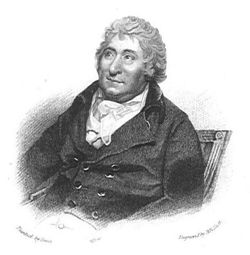Annotation:Harlequin Every Where: Difference between revisions
m (Text replacement - "garamond, serif" to "sans-serif") |
No edit summary |
||
| Line 1: | Line 1: | ||
---------- | |||
---- | {{TuneAnnotation | ||
[[File:dibdin.jpg|250px|thumb|left|Charles Dibdin]] | |f_tune_annotation_title= https://tunearch.org/wiki/Annotation:Harlequin_Every_Where > | ||
|f_annotation=[[File:dibdin.jpg|250px|thumb|left|Charles Dibdin]]'''HARLEQUIN EVERY WHERE.''' English, Country Dance Tune (6/8 time). A Major. Standard tuning (fiddle). AABB. '''The Mirror: or, Harlequin Every-Where''' was a 'pantomimical burletta' in three parts, staged at the Theatre-Royal in Covent-Garden in 1779. Music was composed by [[wikipedia:Charles_Dibdin]] (1745-1814). | |||
'''HARLEQUIN EVERY WHERE.''' English, Country Dance Tune (6/8 time). A Major. Standard tuning (fiddle). AABB. '''The Mirror: or, Harlequin Every-Where''' was a 'pantomimical burletta' in three parts, staged at the Theatre-Royal in Covent-Garden in 1779. Music was composed by | Dance directions were entered into the commonplace book of Seabrook, New Hampshire, musician Jeremiah Brown, which contains melodies and figures of country dances, begun c. 1782. The tune appears in the c. 1770 music manuscript of Lincoln musician William Clark, although likely entered at a later time, in another hand ("[[Vento's Farewell]]" is on the facing page, also printed by the Thompson's, and likely entered into the ms. at the same time). [[File:harlequineverywhere.jpg|450px|thumb|right|A scene in Tartarus (the Greek Hell)]] | ||
Dance directions were entered into the commonplace book of Seabrook, New Hampshire, musician Jeremiah Brown, which contains melodies and figures of country dances, begun c. 1782. The tune appears in the c. 1770 music manuscript of Lincoln musician William Clark, although likely entered at a later time, in another hand ("[[Vento's Farewell]]" is on the facing page, also printed by the Thompson's, and likely entered into the ms. at the same time). | |f_source_for_notated_version= | ||
|f_printed_sources=Thompson ('''Compleat Collection of 200 Favourite Country Dances vol. 5'''), 1788; No. 157, p. 79. | |||
|f_recorded_sources= | |||
|f_see_also_listing= | |||
[[File:harlequineverywhere.jpg|450px|thumb|right|A scene in Tartarus (the Greek Hell)]] | }} | ||
Revision as of 15:32, 23 January 2023
X:1 T:Harlequin Every Where M:6/8 L:1/8 R:Country Dance B:Samuel, Ann & Peter Thompson - Compleat Collection of 200 Favourite Country Dances, vol. 5 B:(London, 1788, No. 157, p. 79) Z:AK/Fiddler's Companion K:A A2A BGE|ecA BGE|e2 e f2e|edc B3| A2A BGE|ecA BGE|e2e f2e|dcB A3:| |:c2B AAA|e2d ccc|a2g f2e|edc B3| c2B AAA|e2d ccc|a2e f2e|dcB A3:|]



